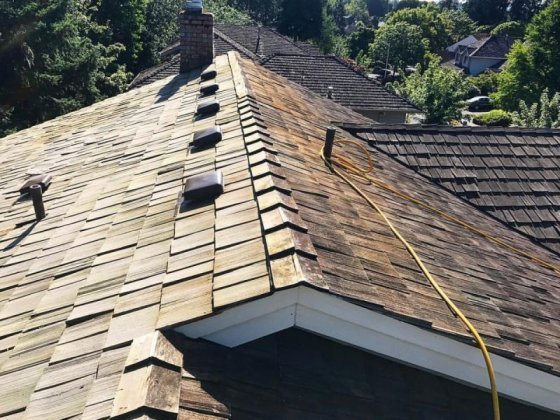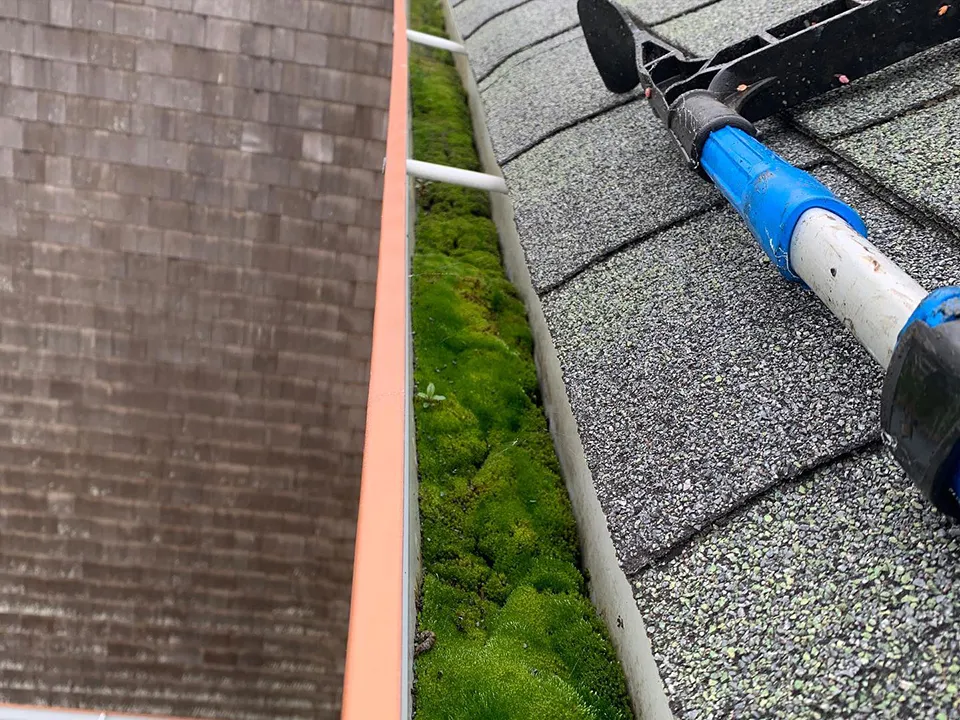Important Tips for Successful Moss Removal to Boost Your Outside Room
Moss can be a relentless issue in outside areas, usually thriving in shaded and damp areas. Understanding the underlying causes of moss development is vital for effective removal and avoidance. Identifying the right techniques and devices is essential for tackling this problem. Additionally, maintaining a healthy and balanced outdoor setting can significantly reduce the possibilities of moss returning. Discovering efficient approaches can transform disregarded areas right into vibrant landscapes. What actions can one require to assure long lasting outcomes?
Comprehending the Sources Of Moss Growth
Although moss can include an attractive quality to landscapes, its growth frequently indicates underlying issues in the atmosphere. Generally, moss thrives in wet, shaded locations where sunlight is limited, creating a perfect habitat for its proliferation. Poor water drainage and compressed soil add significantly to its spread, as these conditions maintain wetness and hinder appropriate water runoff. Additionally, acidic dirt can prefer moss over preferred plants, resulting in imbalances in the ecological community. High moisture and constant rainfall further intensify the trouble, allowing moss to flourish where various other plant life battles. Absence of competition from grass yards can additionally help with moss development, specifically in disregarded locations. On the whole, recognizing the root causes of moss growth is important for efficient monitoring and removal, guaranteeing that exterior areas can return to their designated aesthetic and environmental feature. Dealing with these underlying problems is necessary to prevent future moss invasions.
Determining Locations Prone to Moss Build-up
Identifying areas susceptible to moss build-up is essential to reliable management and avoidance. Moss prospers in atmospheres that are moist, shaded, and have inadequate drainage. Areas under trees or thick hedges typically experience low sunshine, developing perfect problems for moss development. In addition, areas with compressed soil, such as paths or heavily trafficked grass, might maintain wetness, further promoting moss proliferation.
Moreover, badly draining surfaces like concrete or asphalt can additionally end up being moss hotspots, particularly in shaded places. Home owners need to routinely evaluate their outside spaces, seeking indications of moss on roof coverings, outdoor patios, and yard beds. Identifying these locations enables aggressive measures to be taken, such as enhancing sunshine exposure, boosting drain, or adjusting landscaping. By identifying these susceptible zones, individuals can better plan for and stop future moss issues, inevitably resulting in a much healthier and a lot more visually pleasing outside room.

Effective Moss Removal Techniques
Removing moss successfully calls for a mix of techniques customized to the specific surfaces and conditions where moss has actually taken hold. For tough surfaces such as patio areas and driveways, a pressure washer can be very reliable, blasting away moss without damaging the underlying product. When taking care of softer surfaces like roofing systems or wooden decks, a gentler approach is needed; making use of a soft-bristle brush and a mix of vinegar and water can aid dislodge moss without triggering harm.

Preventing Future Moss Growth
To stop future moss development, it is necessary to enhance sunshine direct exposure and improve drainage systems. Increasing sunshine can discourage moss from thriving in shaded locations, while reliable drainage reduces wetness accumulation. Executing these methods can produce a setting less for moss spreading.
Boost Sunlight Exposure
How can enhancing sunlight exposure effectively battle future moss growth? By enabling a lot more sunshine to get to shaded locations, homeowners can substantially hinder the excellent conditions that moss grows in. Moss usually flourishes in dark, moist settings; for that reason, boosting light availability can disrupt its life cycle. Strategic tree cutting or elimination may be needed to enhance sunlight in affected areas. In addition, making use of reflective surface areas, such as light rocks or patio area products, can even more improve light penetration. On a regular basis preserving and monitoring yard wellness likewise guarantees that sunlight can get to the ground properly. Carrying out these procedures not only lowers the probability of moss regrowth yet likewise promotes a much healthier, a lot more dynamic exterior room.

Boost Drainage Solutions
Reliable water drainage systems play a vital role in avoiding future moss growth in household landscapes. It creates a wet atmosphere conducive to moss proliferation when water builds up in certain locations. To enhance water drainage, house owners need to this website analyze their landscape for low-lying areas and think about mounting French drains or swales to redirect excess water. Normal maintenance, such as clearing rain gutters and downspouts, will certainly also promote effective water circulation. Additionally, making certain that soil is well-aerated can boost absorption and decrease water pooling. Planting drought-resistant greenery can even more minimize dampness retention, developing a negative environment for visit this page moss. By addressing drainage issues proactively, property owners can greatly decrease the possibility of moss taking hold and preserve a healthier, much more dynamic exterior space.
Choosing the Right Products for Moss Control
When picking items for moss control, home owners have to weigh the advantages of chemical versus all-natural options. Each choice provides possible downsides and unique advantages, affecting effectiveness and environmental impact. In addition, comprehending different application approaches can assure perfect cause moss elimination efforts.
All-natural vs. Chemical Solutions
While both all-natural and chemical remedies provide practical options for moss control, the selection commonly depends upon specific preferences, environmental factors to consider, and the extent of the moss problem. All-natural options, such as vinegar, cooking soft drink, or salt, are typically favored for their eco-friendliness and low poisoning. They can efficiently hinder moss growth without damaging bordering plants or soil health. On the other hand, chemical options have a tendency to be much more potent and can supply quicker outcomes, making them suitable for extreme infestations. They may posture dangers to non-target microorganisms and the atmosphere if misused. Inevitably, the choice between all-natural and chemical products should mirror an equilibrium of effectiveness, safety and security, and the total influence on the outside space.
Application Techniques Explained
Picking the ideal products for moss control entails comprehending the different application approaches available. House owners can pick between granular, liquid, and foam products based on their preferences and the particular area influenced by moss. Granular options are commonly spread over the webpage moss-infested location, enabling for steady absorption and efficiency. Liquid therapies, often applied with a sprayer, offer immediate protection and penetration, making them appropriate for larger areas. Foam products give targeted application, which can be advantageous for elaborate surfaces like walls or roofing systems. Furthermore, elements such as weather and surface kind must be taken into consideration when selecting a technique. Inevitably, understanding these techniques makes it possible for reliable moss control, ensuring a healthier and extra attractive outdoor room.
Keeping a Healthy Outdoor Space After Removal
After moss removal, it is crucial to apply efficient upkeep techniques to assure the outside room continues to be dynamic and healthy. Normal grass treatment is essential; cutting at the proper height advertises turf wellness and discourages moss regrowth. Additionally, guaranteeing sufficient sunlight reaches the yard and yard areas is essential, as moss thrives in shaded atmospheres.
Dirt wellness must additionally be focused on. Checking soil pH and nutrient levels can guide appropriate modifications, cultivating a durable ecosystem. Appropriate drainage is an additional crucial aspect; attending to any pooling water can prevent moss from improving itself.

Frequently Asked Questions
Can Moss Be Beneficial for My Garden or Landscape?
Moss can be advantageous for gardens and landscapes by offering ground cover, retaining moisture, and improving dirt top quality. It additionally cultivates biodiversity, supplying habitat for tiny microorganisms and improving the general visual allure of outside spaces.
The length of time Does It Consider Moss to Grow Back After Elimination?
Moss can regrow within a couple of weeks to a number of months after elimination, relying on environmental problems like soil, moisture, and color quality. Regular maintenance is necessary to protect against quick reestablishment in influenced locations.
Is Moss Elimination Harmful to Surrounding Plants or Wildlife?
Moss elimination can possibly damage surrounding plants and wildlife, particularly if chemical therapies are made use of. Hand-operated elimination, nevertheless, typically poses very little risk, though treatment should be required to avoid troubling nearby vegetation and environments during the process.
What Season Is Best for Moss Removal?
The very best time for moss elimination is usually in very early spring or late autumn. During these seasons, temperature levels are moderate, and wetness degrees can help assist in the elimination procedure while decreasing tension on bordering plants.
Just How Can I Tell if Moss Is Simply inactive or dead?
To identify if moss is dead or inactive, one need to check its color and structure. Healthy and balanced moss shows up environment-friendly and vibrant, while dead moss has a tendency to be brownish and weak, lacking moisture and elasticity.
Commonly, moss thrives in wet, shaded locations where sunshine is restricted, creating an optimal environment for its spreading. Removing moss effectively needs a combination of techniques tailored to the details surfaces and conditions where moss has actually taken hold. Boosting sunlight can discourage moss from thriving in shaded areas, while efficient water drainage minimizes moisture build-up. By enabling a lot more sunshine to get to shaded locations, homeowners can considerably impede the perfect conditions that moss grows in. While both chemical and all-natural options offer viable choices for moss control, the selection often depends on individual preferences, ecological considerations, and the severity of the moss problem.